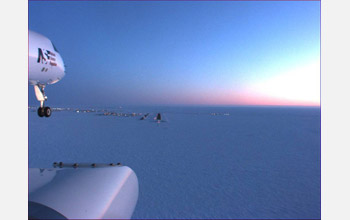Multimedia Gallery
HIPPO Project (Image 3)
View from HIAPER, a modified Gulfstream-V (G-V) aircraft, as it approaches the runway during the HIAPER Pole-to-Pole Observations (HIPPO) project, a landmark study where scientists are attempting to systematically map the global distribution of carbon dioxide and other greenhouse gases in the atmosphere. HIAPER was designed and developed by the National Science Foundation (NSF) for high-altitude observing and advanced research.
The HIPPO project is investigating the carbon cycle and greenhouse gases throughout various altitudes of the Western Hemisphere throughout the annual cycle. HIPPO is supported by NSF and its operations are managed by the Earth Observing Laboratory (EOL) of the National Center for Atmospheric Research (NCAR). The main goal of the program is to determine the global distribution of carbon dioxide and other trace atmospheric gases by taking samples at various altitudes and latitudes in the Pacific Basin.
The research will be conducted by a 10-person team aboard HIAPER, a modified Gulfstream-V (G-V) aircraft that was designed and developed by NSF for high-altitude observing and advanced research. The research will take place over a 27-day period, traveling over 30,000 miles, sampling atmospheric gases from sea level up to 45,000 feet. Further information about the HIPPO project is available Here.
NCAR is supported by NSF and other federal agencies to provide facilities and support for a wide range of studies in the atmospheric and related sciences. NCAR is managed by the University Corporation for Atmospheric Research (UCAR), a nonprofit consortium of universities that grants Ph.D.s in fields related to atmospheric science. UCAR's primary function is managing NCAR. To learn more, visit the NCAR website, Here. [Research supported by NSF grant ATM 06-28575.] [Image 3 of 3 related images. Back to Image 1.] (Date of Image: 2009)
Credit: Photo by GV Camera, ©University Corporation for Atmospheric Research
Images and other media in the National Science Foundation Multimedia Gallery are available for use in print and electronic material by NSF employees, members of the media, university staff, teachers and the general public. All media in the gallery are intended for personal, educational and nonprofit/non-commercial use only.
Images credited to the National Science Foundation, a federal agency, are in the public domain. The images were created by employees of the United States Government as part of their official duties or prepared by contractors as "works for hire" for NSF. You may freely use NSF-credited images and, at your discretion, credit NSF with a "Courtesy: National Science Foundation" notation.
Additional information about general usage can be found in Conditions.
Also Available:
Download the high-resolution JPG version of the image. (284 KB)
Use your mouse to right-click (Mac users may need to Ctrl-click) the link above and choose the option that will save the file or target to your computer.

